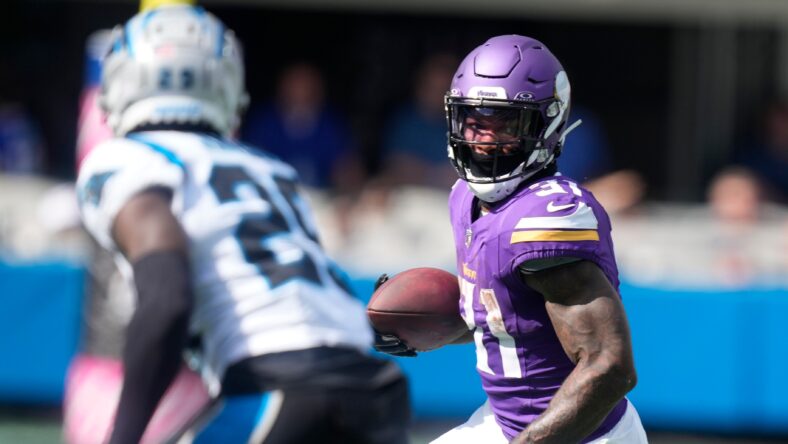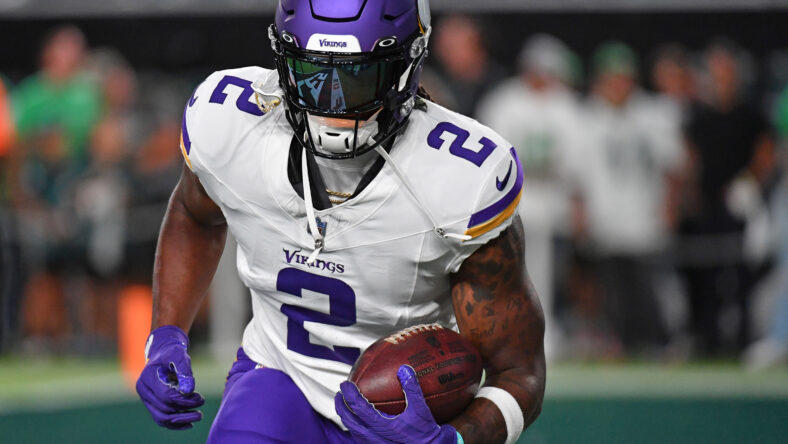Newcomer Viking’s Impact Was Quite Appealing

The Minnesota Vikings subtracted the less from winless by downing the Carolina Panthers on Sunday afternoon, topping Frank Reich’s team 21-13 in a rollercoaster affair.
Teams that begin seasons 0-3 are unlikely to reach the postseason but maintain a flicker of hope for change, while 0-4 teams are effectively dead-dead, at least per NFL history.
Newcomer Viking’s Impact Was Quite Appealing
But this brand of Vikings is back, if only for a week.

And one man contributed significantly to the Vikings reversal of fortune, Cam Akers, a running back obtained via trade a week and a half ago.
Here’s how that shook out and why it’s vital for the season’s remainder.
The Numbers

Akers touched the football 7 times in his Vikings debut, depositing 51 yards from scrimmage via rush and reception. Of course, that isn’t a Hall of Fame ticket, but the 7.28 yards per touch is noteworthy.
Why? Well, it’s damn good.
His 7.28 yards per touch against the Panthers was the most by a Vikings running back in his debut game with the team (min. 5 touches) since Adrian Peterson in 2007. And it was the fifth-most in team history with the same statistical parameters.
Akers could’ve been a nothingburger and swallowed up by the Panthers defense — that’s happening to Dalvin Cook in New York through four games — but that did not occur. He was given the ball seven times, and to a degree, he balled out.
The Salt and Pepper Effect

Interestingly, Akers took over for Dalvin Cook at Florida State in 2018. Now, with an eerie twist of fate, he could take “The Cook Role” within the Vikings offense some five years later.
Minnesota absolutely refused to run the football in Weeks 1 and 2, tabulating historically low [bad] rushing-playcall rates. That may be fine and dandy if the team wins games, but it was not winning anything. Kevin O’Connell and friends have increased the ground-game production in back-to-back weeks, and minus turnovers, the club is moving the ball more efficiently and trying to fix the dastardly time of possession woes.
Adding Akers almost “forces” the Vikings to run the ball more, and Akers’ skillset is a Cookian contrast to Mattison’s. He has more burst, and Mattison has a bowling-ball effect against opposing defensive fronts.
Just like that, the Vikings are back to a 2019-2022 rushing attack, at least stylistically.
Now What?

Akers did nothing on Sunday to lessen his workload. In fact, his immediate production suggests he’ll be interwoven into the offense at an enhanced clip. General manager Kwesi Adofo-Mensah always says he doesn’t miss a chance to add more talent to the depth chart, and he did precisely that in Akers.
From Week 5 to the end of the Vikings season, expect Akers to get more touches, likely approaching an equitable workload with Mattison. Before Cook departed, the Vikings used to insert Mattison on “Mattison drives,” and before too long, Minnesota might simply alternate drives between Akers and Mattison — because that’s how RB committees work.
Dustin Baker is a political scientist who graduated from the University of Minnesota in 2007. Subscribe to his daily YouTube Channel, VikesNow. He hosts a podcast with Bryant McKinnie, which airs every Wednesday with Raun Sawh and Sal Spice. His Vikings obsession dates back to 1996. Listed guilty pleasures: Peanut Butter Ice Cream, ‘The Sopranos,’ Basset Hounds, and The Doors (the band).
All statistics provided by Pro Football Reference / Stathead; all contractual information provided by OverTheCap.com.

You must be logged in to post a comment.